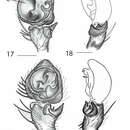Karaops: Brief Summary
provided by wikipedia EN
Karaops is a genus of Australian wall spiders that was first described by S. C. Crews & Mark Stephen Harvey in 2011.
- license
- cc-by-sa-3.0
- copyright
- Wikipedia authors and editors
Description
provided by Zookeys
Total length 3.90–10.30.Cephalothorax:Carapace with some dusky marks, usually wider than long. Fovea longitudinal, broad, and shallow. Setae variable, ranging from soft to thick and coarse, short peg-like spines to long and thin; some are of medium length and thickness. Chelicerae slightly geniculate, robust, with 3 prolateral and 2 retrolateral teeth, or 4 prolateral and 3 retrolateral teeth.Eyes:AER straight to slightly recurved to recurved, PER slightly recurved to strongly recurved. PME larger than AME in most species, though equal or smaller in some specimens.Legs:Leg III usually longest, though leg II or IV is longest in some species. Leg pattern 3241in most specimens, but is variable both between and within species, as inSelenops. Tibial and metatarsal ventral spination is primarily in pairs of 5 and 3, respectively, but can also be 6–3, 5–4, 6–4, 5–0, or are unpaired. Tarsal scopulae absent.Female copulatory organs:Epigynum with lateral lobes, a well-defined median area, and withor without epigynal pockets. Spermathecae and internal ducts range from simple and round to highly coiled.Male copulatory organs:Palpal tibia with 2 or 3 tibial apophyses. Dorsal apophysis longer than or equal to ventral apophysis in most species. MA 1 or 2 branched, ranging from unsclerotized to strongly sclerotized.
- license
- cc-by-3.0
- copyright
- Sarah C. Crews, Mark S. Harvey
- bibliographic citation
- Crews S, Harvey M (2011) The spider family Selenopidae (Arachnida, Araneae) in Australasia and the Oriental Region ZooKeys 99: 1–104
- author
- Sarah C. Crews
- author
- Mark S. Harvey
Distribution
provided by Zookeys
Karaopsgen. n.occurs throughout mainland Australia, but is apparently absent from Tasmania (Maps 4–10).
- license
- cc-by-3.0
- copyright
- Sarah C. Crews, Mark S. Harvey
- bibliographic citation
- Crews S, Harvey M (2011) The spider family Selenopidae (Arachnida, Araneae) in Australasia and the Oriental Region ZooKeys 99: 1–104
- author
- Sarah C. Crews
- author
- Mark S. Harvey

